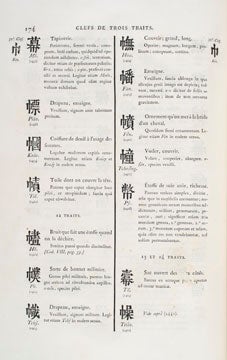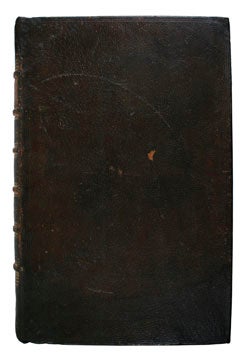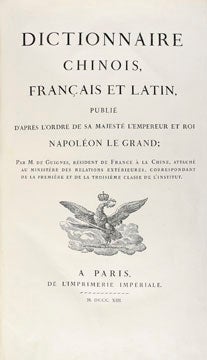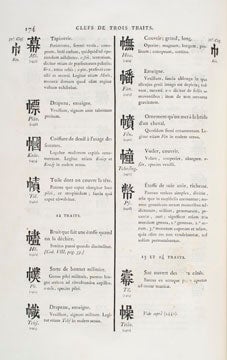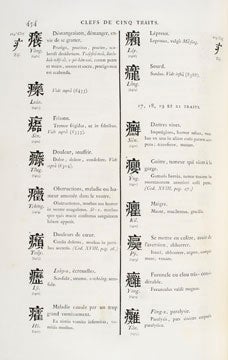Dictionnaire chinois, francais et latin
GUIGNES, Chretien-Louis-Joseph de. Dictionnaire chinois, français et latin. Publié d'après l'ordre de sa majesté L'Emperuer et Roi Napoléon le Grand par M. de Guignes, résident de France à La Chine, Attaché au Ministère des Relations Extérieures, Correspondant de la Première et de la Troisieme Classe de L'Institut. [8], lvi, 1112, [4] pp. Thick folio, 475 x 310 mm, bound in contemporary French brown-stained pigskin, raised bands, tan morocco spine label stamped in gilt. Paris: l'Imprimerie Imperiale, 1813.
First Edition. A massive, imposing Chinese dictionary commissioned by Napoleon in 1809, and an important work in the development of Western scholarship on China. Although given no credit in the book, the dictionary is actually a re-edit of work compiled by the Franciscan friar, Basilio de Glemona Brollo (1648-1704) during his thirty years of missionary work in China in the seventeenth-century. His work was considered among the finest of the Missionary lexicons.
Chretien-Louis-Joseph de Guignes (1759-1845), listed on the title-page as the sole author, was in fact only responsible for the editing and the French translations of the ideograms. Despite this overstated role in the creation of the dictionary, de Guignes was a prominent sinologist who lived, traveled and worked in China for 17 years, and was the son of another great sinologist, Josef de Guignes. His was the author of an extensive travel guide of China entitled Voyages à Peking, Manille et l'île de France, faits dans l'intervalle des années 1784 à 1801.
De Guignes served as interpreter for Issac Titsingh, the Dutch ambassador to the court of the Emperor Qianlong in 1794-95. The members of the Titsingh mission were the only welcomed westerners in China at the end of the Qianlong dynasty. One speculation being that they were willing (unlike the British) to perform the "kowtow" at Court in front of the Emperor, according to Chinese custom. Thus, de Guignes was among the last European diplomats to be allowed inside Yuanmingyuan (The Peking Summer Palace) and to observe the incomparable splendour of Qianlong's pleasure gardens and palaces before their destruction by the Lord Elgin's troops during the Second Opium War in 1860.
The dictionary is an impressive piece of typography containing over 13,000 woodcut Chinese characters. Interestingly they were cut nearly one hundred years earlier for a separate project involving the Chinese works in the Royal Library. The characters are arranged by the order of their complexity, each with the phonetic pronunciation and the Latin and French translation, including several indexes at the end on tones and numeric characters. Some light marginal waterstains to a few leaves, professionally rebacked with the original spine laid down, still a fine copy.
Cordier 1589. Lust 1037. Lowendahl 763. Brunet II, 568.
Item nr. 130234
Price:
$15,000.00

